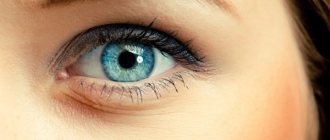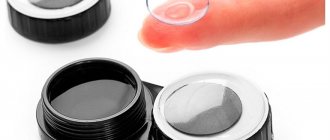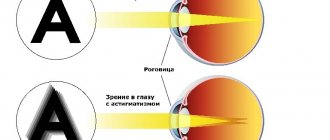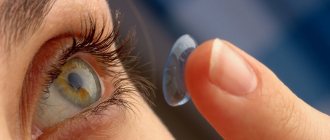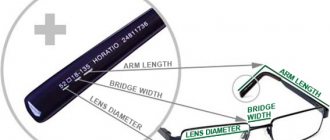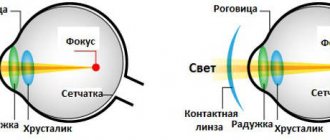Many parents are interested in the question: can children wear contact lenses? The safety of these optical products for children's eyes raises many doubts among adults. It is a common belief that children are allowed to use contact lenses only after reaching adulthood. What do ophthalmologists think about this and what is the situation really like?
Contact lenses
Contact lenses allow you to get higher quality vision and full lateral vision. Before purchasing such a product, you need to study all the advantages and disadvantages.
Advantages
The lenses do not in any way affect the size of the image that the patient sees. Vision with lenses is more natural, as they do not limit the field of view. The lenses allow you to easily tolerate large diopter differences between the eyes.
Advantages of contact correction:
- products do not fog up in winter;
- the ability to deal with active ports;
- eye protection from microtraumas;
- Possibility of tinting and changing eye color.
Clear contact lenses are invisible on the eyes, so they do not affect your appearance in any way.
Flaws
The main disadvantage of contact correction is the need for special care of the products. To do this, you will need a storage container, solution and special tweezers.
REFERENCE. Sometimes, upon contact with the cornea of the eye, an allergic reaction or inflammatory process occurs.
This deviation occurs due to insufficient lens care.
Lenses require more frequent replacement. When wearing lenses, you must have glasses, since they cannot be worn during illnesses and inflammation.
How to choose
To choose contact lenses, you need to contact a specialist. The first thing he will do is collect anamnesis. Lens selection algorithm:
- visual acuity test;
- ophthalmometry and biomicroscopy;
- calculating the optimal parameters of the product;
- first fitting, assessment of risk and quality of vision;
- training on use.
At the last stage, the ophthalmologist explains to the patient the basic rules for wearing lenses.
What parameters should you pay attention to?
When choosing contact lenses, you need to pay attention to a number of parameters. The main ones:
- patient's age;
- the presence of allergic reactions;
- experience wearing glasses;
- taking medications;
- bad habits;
- the presence of an inflammatory process of the eyes.
When choosing lenses, the specialist must pay attention to the patient’s capabilities and needs.
Rules that must be followed when wearing contact lenses
There are a number of rules that must be followed to ensure that contact correction is comfortable and does not cause vision deterioration.
IMPORTANT. The main condition is to follow all hygiene recommendations.
Lenses should only be put on with clean and dry hands. You should dry your hands with a towel that does not leave lint.
Rules for wearing contact lenses:
- Lenses must be put on before applying makeup.
- The surface of the eye should not be exposed to particles when spraying aerosols. They settle on the lenses, thereby contaminating them.
- It is undesirable to be in a heavily smoky or gas-filled room.
- With this vision correction, you cannot swim, as dirt and microorganisms present in the water can get into the lens.
- Do not use medicated eye drops if you have lenses on your eyes.
- It is necessary to carefully follow the rules for caring for contact products.
- The storage container must not be washed with water, boiled or treated with disinfectants.
An important aspect is compliance with the terms of wearing the corrective product. You cannot sleep or stay in hydrogel lenses for more than 10 hours. Silicone hydrogel products are designed for prolonged use.
Lens care rules
Caring for your lenses depends on their type. Gas-tight and gas-permeable hard lenses do not grow with fungi and dangerous microorganisms. They must be stored in an aqueous environment in a container. For this, a special solution is used to disinfect the product.
Due to the presence of silicone in the composition, it reduces the wettability of the lens. To eliminate this problem, special solutions are used. They contain binders, disinfectants and wetting agents.
REFERENCE. Soft lenses require more complex care.
For storage, you should use special saline solutions, which in their composition resemble tears. Such products must be cleaned of deposits.
Features of selection
Properly selected contact lenses, both for myopia and farsightedness, should:
- Be comfortable and made from material that is safe for eye health.
- Have a correctly selected radius of curvature, diopter and thickness.
- Have an optimal diameter for the eyes.
According to the wearing mode, lenses are divided into:
- Daily wear lenses. They need to be removed before going to bed, treated with a special solution and stored in a container.
- Extended wear lenses. They can be worn without taking them off for a week or more.
- Lenses with flexible wearing mode. Can be worn for up to two days in a row.
- Constant wear lenses. They can be worn for a whole month.
You can find out more about multifocal contact lenses in the material.
It should be remembered that if a child has contraindications to wearing lenses, then they should not be used. Factors that prevent you from wearing lenses include:
- Eye inflammation: conjunctivitis, keratitis, scleritis, uevitis, blepharitis and so on. Lenses can cause irritation, poorly transmit oxygen, and therefore can lead to exacerbation of inflammatory diseases.
- Inflammation of the lacrimal sac, obstruction of the lacrimal ducts and insufficient production of tear fluid. First you need to eliminate these problems, and then you can wear lenses.
For myopia
Only an ophthalmologist can choose the right lenses. Under no circumstances should you experiment and select lenses for your child on your own, otherwise your vision will deteriorate even more. An ophthalmologist conducts an examination during which he determines visual acuity, the condition of the cornea and other structures of the eye. Based on this, the doctor selects the required optical power of contact lenses and their other parameters. In most cases of myopia, soft contact lenses are prescribed.
Stages of selecting lenses for myopia:
- A trip to the ophthalmologist’s office, where a full examination is carried out, but on the basis of which the doctor will give his recommendations.
- Purchasing lenses. When buying lenses, you should give preference to well-known manufacturing companies whose products have already proven themselves in the market as high quality. In general, it is best to consult an ophthalmologist on this issue if you are purchasing lenses for the first time.
- The choice of lenses depending on the period of wear. The shorter the period, the better, since with prolonged wear, germs and deposits accumulate in greater quantities.
- Cost of lenses. You should not chase profit and buy cheap lenses that can harm the health of your child’s eyes.
- Lens material. Silicone hydrogel is recognized as the best material. It allows oxygen to pass through well and ensures eye hydration throughout the entire period of wearing.
For farsightedness
Farsightedness or hypermetropia is a visual impairment characterized by the fact that a person has difficulty seeing objects located at a close distance from him. Correctly selected contact lenses for the correction of farsightedness should help your child see clearly both near and far.
Just as when selecting lenses for myopia, an ophthalmologist should select lenses to correct farsightedness. Farsightedness can be corrected with spherical lenses. And if a child sees poorly both near and far, then he will be prescribed multifocal contact lenses, which have several zones that are responsible for correcting near and far vision.
Find out what eye drops your doctor may prescribe for glaucoma in this article.
How to choose lenses for a child
The selection of funds is carried out by an ophthalmologist. At the first visit to the doctor, he prescribes a full examination intended for young and young patients.
The ophthalmologist examines the condition of the front part of the eye to exclude contraindications that would make the use of CL impossible. Then the doctor uses special instruments to determine the parameters of the child’s eye.
It is important to find out the base curve, diameter, degree of visual impairment and optical power. The doctor gives a product that meets the listed parameters
The child walks in it for 2–3 hours and talks about the sensations.
An ophthalmologist examines the fundus of the eye in the product and determines the clarity of visual perception. If they are suitable in all respects and do not cause visual distortion, discomfort, irritation or redness, the doctor writes a prescription.
It is recommended to use one-day products. Such products are put on in the morning and disposed of in the evening. They are the safest, eliminating the risk of infection, since they are not reused. One-day products do not require any maintenance.
Lenses for children: at what age can you wear lenses?
Unfortunately, visual impairment in children is becoming more common.
Glasses have proven to be a good means of vision correction for young patients.
THIS IS INTERESTING: Decorative lenses for eyes
They correct vision well and help achieve its restoration at the initial stage of eye disease.
In addition to glasses, there are many vision correction products on the market, differing in price, functionality and other qualities. Let's consider the use of lenses for children, since many parents have different opinions about this method of correction.
The benefits of contact lenses for children
Using lenses has the following advantages:
- Lenses create a single system with the eye, allowing you to achieve high-quality images;
- Lenses do not change the size of the image and do not distort its contours;
- Owners of contact lenses do not know such problems as “sweating” of glasses when entering a warm room from a cold room;
- A person's appearance does not change;
- Shyness and the appearance of psychological problems in connection with wearing glasses are excluded.
There are many quality contact lenses on the market. They have a high permeability to oxygen.
Contact lenses are the optimal solution for correcting visual impairment in children. They are prescribed to patients with refractive errors, varying degrees of amblyopia and lens defects.
At what age is it legal to wear contact lenses?
It is traditionally believed that contact lenses are prescribed to children from the age of 14.
In some cases, lenses are prescribed from 6-7 years of age. Some ophthalmologists recommend prescribing lenses for children from 6 to 7 years of age. At the same time, the child must be able to take care of them himself. Doctors explain such an early start to wearing lenses by the fact that even young children can learn to treat lenses conscientiously and care for them. And it’s easy to teach them how to put on and take off such lenses.
Contact lenses for children of such a young age are not sold in regular stores. They must be ordered according to an individual prescription, which is selected by an ophthalmologist. For such cases, doctors recommend hydrogel lenses, which are most suitable for the still unformed cornea of the eyes.
For children 7-8 years of age, disposable lenses can also be prescribed. With them there will be much less problems in operation. However, then the child must be taught to use reusable lenses: that the lenses must be put on, taken off and stored in a special container.
How to choose the right contact lenses for children
Correctly selected lenses help the correct development of the eyes, without complications and problems. Their selection is carried out only by a doctor. Stages of correct lens selection:
- Determination of eye pathologies;
- Diagnostics of eye parameters for lens selection;
- Diagnostics of eye refraction;
- Ophthalmoscopy;
- First fitting of a contact lens;
- Clarification of the optical power of the lens after all studies have been completed.
After the final selection of lenses, the child and parents are instructed on wearing lenses and caring for them.
How parents should supervise their children's lens wear.
Parents should know that only strict adherence to all the doctor’s advice will contribute to 100% vision correction. To do this, they must monitor the child and help him comply with the doctor's requirements.
Parents should explain to their child that they should not sleep in lenses. Also, you cannot wear them longer than the period specified by the manufacturer.
To fully control the child, parents should follow simple rules and tips:
- It is necessary to assess how responsibly he will follow the doctor’s recommendations;
- Parents themselves need to be informed about the specifics of wearing lenses by their child;
- If it is clear that the child needs to be reminded to wash the dishes, make the bed, etc., then it is obvious that he will have the same attitude towards wearing lenses;
- It is necessary to create a certain motivation for the child to wear them;
- Monitoring of the child should be carried out unobtrusively;
- If you have any problems, you should consult a doctor.
When do doctors prescribe lenses for children?
Some parents believe that children can only wear lenses if they are nearsighted. Others believe that these optical products can cope with the correction of myopia and hypermetropia, but they cannot help with astigmatism. Many adults are sure that lenses for children are intended if diseases such as aphakia - absence of a lens or anisometropia - are detected. For what visual impairments are children allowed to use contact lenses? Wearing optical products is allowed for diseases such as:
- myopia;
- farsightedness;
- astigmatism;
- amblyopia;
- anisometropia;
- aphakia.
In each specific case, the decision about whether children can wear lenses should be made by an ophthalmologist. Sometimes doctors prefer to replace contact lenses with glasses. This is not possible in all cases. With anisometropia, the difference between the optical powers of the eyes may be so different that glasses cannot be used. Most often, doctors prescribe contact lenses for myopia. This visual impairment is very common among schoolchildren. For farsightedness, contact lenses are prescribed much less frequently.
Ophthalmologists prescribe contact correction products for children and astigmatism. Doctors recommend that parents purchase optical products that are made from silicone hydrogel material. Such models are considered the most suitable for children's eyes. For astigmatism up to 1.5D, it is possible to use spherical contact lenses for children. If vision decreases by more than 1.5 D, special optical products are no longer necessary. Optometrists prescribe toric contact lenses.
Indications for use
Contact lenses are prescribed to children in the following cases.
- Myopia (myopia).
Contact lenses are available to correct almost any degree of myopia. - Farsightedness (hypermetropia).
Correction of high degrees of hyperopia with lenses is not only a more aesthetic type of correction, but also a more physiological one.In contact lenses, the child sees objects of true size and perceives them at the distance at which they actually are, in contrast to spectacle correction, which enlarges and brings objects closer (and this negatively affects the child’s psyche and increases the risk of street injuries).
- Astigmatism is one of the common causes of low visual acuity in preschool children.
Today, soft toric lenses can correct astigmatism up to 2.5-3.0 diopters. - Anisometropia is a condition in which the refraction of the right and left eyes is different.
A small degree of anisometropia (up to 1.5–2.0 diopters) is quite easily tolerated and corrected with glasses.In cases of a refraction difference of more than 3.0 diopters, the child uses the best - dominant - eye, and the image from the worse-seeing eye is suppressed by the brain, and this eye does not participate in the formation of the visual image.
Congenital anisometropia, as a rule, is one of the causes of amblyopia. High anisometropia is a direct indication for the selection of contact lenses.
- Amblyopia.
As a rule, school-age children with amblyopia have difficulty agreeing to follow one of the doctor’s main recommendations - to cover the better-seeing eye with an occluder or tape it with an adhesive plaster.In this case, the child can be successfully penalized using soft contact lenses.
Penalization (from the French penalite - punishment, fine), artificial deterioration (fogging) of vision in the better-seeing eye through correction, is one of the effective methods of treating amblyopia.
- Aphakia.
The optimal vision correction for children after removal of both congenital and traumatic cataracts today is contact correction.
Selection of contact lenses by a doctor
There are eight main stages in selecting contact lenses for children and adolescents:
- Examination with a slit lamp in order to exclude pathology of the anterior segment of the eye, which serves as a contraindication to the selection of contact correction.
- Determination of eye parameters for selecting a trial contact lens (determining the diameter of the cornea and choosing the diameter of the contact lens; determining the radius of curvature of the cornea on a keratometer and choosing the base curvature of the contact lens).
- Determination of clinical refraction of the eyes to select the optical power of a contact lens.
- Conducting an ophthalmoscopy to identify non-optical causes of low vision.
- Trying on a contact lens - assessing the position and mobility of the contact lens on the eye (the mobility of the contact lens in children should be slightly less than in adults), determining visual acuity.
- Clarification of the final optical power of a contact lens after determining the residual refraction on the eye with a contact lens.
- The final choice of contact lens.
To make sure that you are choosing the right type of contact lens, you need to try on several contact lenses of different designs and choose the one that provides optimal alignment and mobility and maximum visual acuity and comfort. A soft contact lens should fit more tightly to a child's cornea than an adult's to prevent it from falling out of the eye and being lost. - Instructing children and their parents on wearing and caring for contact lenses.
The doctor must make sure that, if necessary, the parents will be able to remove the contact lens from the child’s eye.
Finally, the doctor must:
- Have full contact with parents. Parents must clearly understand the objective need for contact lenses for their child; they must be aware of all the positive and negative aspects of contact correction.
- Teach parents to put on contact lenses with their child so that if necessary, they can help him put on or remove a contact lens.
- Instruct parents how to clean and store contact lenses. Simplicity, effectiveness and safety of contact lens care products are very important; preference should be given to multifunctional solutions.
- Carry out the next change of contact lenses with mandatory monitoring of visual acuity, each time checking the fit of new contact lenses.
Monitor the correct use, cleaning and storage of contact lenses and ensure that they do not cause any undesirable effects
Lenses: contact vision correction for children
Children's vision develops during the first 10 years of life, and if vision pathologies are not dealt with, it will become more and more difficult to correct them every year. What treatments are available and when should they be used? Can a child wear contact lenses or just glasses? Doctor of Medical Sciences, ophthalmic surgeon, Professor Svetlana Anisimova answers these and other questions .
“Contact correction - or wearing lenses - is now at the peak of its development. If previously we advised it to children only from the age of 12, now it is possible to use it from the age of 6, and by the time the child goes to school, good results can already be obtained. New polymers have appeared, lenses have become gas-permeable, and the cornea of the eye can breathe in them. In addition, we provide the child with psychological comfort, since glasses are always an inconvenience for sports activities, and increased injury, psychological dependence, and in general, lenses are a different quality of life,” says Professor Anisimova.
Now doctors for congenital eye pathology, for example, after removal of congenital cataracts, allow the use of contact lenses for very young children - from 6 months, if for one reason or another an artificial lens was not installed. lazy” eye is possible - this is a functional, usually reversible decrease in vision, in which one of the two eyes is almost (or generally) is not involved in the visual process. In these cases, ophthalmologists teach parents how to sterilize lenses, and from the age of 6 the child is taught to do it independently. Contact lenses are also used to treat children with progressive myopia or astigmatism. Astigmatism is an optical defect of the eye in which different optical powers are observed vertically and horizontally, and a blurred image is formed on the retina (lack of a single focus). Often the disease is caused by abnormalities in the structure of the eyeball. Toric contact lenses are used to correct astigmatism. They are prescribed when it is impossible to correct vision with glasses,” explains Professor Anisimova.
In conditions of amblyopia, the child uses the healthy eye, but in the other eye, due to the lack of correction, vision does not develop and a “lazy eye” is formed, while the formation of stereo vision is not possible and subsequently the choice of profession is limited. When vision is up to 2 diopters, correction is carried out with glasses, and if the value is higher, the child may feel dizzy in glasses with a big difference in the correction of the right and left eyes.
The number of cases of myopia in the world and in our country is constantly growing. If now up to 5% of children are born with myopia, then by the age of 20 such people become 52%, says Professor Anisimova, parents should, if possible, slow down the progression of myopia. Several such methods have already been developed. Firstly, this is scleroplasty - surgical treatment of progressive myopia. Secondly, this is a hardware program for the treatment of accommodation disorders and eye exercises. And 5 years ago a new technology appeared - orthokeratology. With it, special lenses are worn at night to sleep in them. They put pressure on the cornea, gradually change its shape, and during the day a person sees well, glasses are no longer needed. When we correct vision, it is important that the child sees well, that the internal and external muscles of the eye work, then the rate of development of myopia will decrease. In our center, for example, they opened an office where progressive myopia is treated over the course of a year using various methods, as well as with the help of orthokeratological “night” lenses.
The child wears regular lenses 4-5 days a week, and the eyes rest for 2 days so that the cornea can breathe; with orthokeratological lenses , treatment occurs at night, and the cornea rests during the day.
As for operations, as ophthalmologists say, the situation is very individual. If a child has strabismus and anisometry (a large difference between the eyes), then surgical treatment of the eyes is necessary at an early age, so that both eyes simultaneously participate in the formation of correct vision, for the formation of stereo- and binocular vision.
Regular medical examination, which is carried out for a child from an early age, allows us to identify refractive errors and congenital vision pathologies, and then the doctor decides how best to correct the child. And the options may be different: you can use daily lenses and throw them away at the end of the day, there are contact lenses for 2 weeks. And there are already orthokeratological, night treatment lenses.
“Of course, school loads, the computer, and the child’s fatigue influence the development of myopia,” explains Professor Anisimova. – The internal and external muscles of the eye weaken, myopia progresses. For myopia, surgery may be required, but correction of myopia is usually carried out from the age of 18, when the progression has stopped and its degree has remained stable for the last 2 years. Some clinics perform it earlier, so that in case of “difference of eyes,” both eyes develop equally, but then you will probably have to operate again. Anticipating questions about computers, Professor Svetlana Anisimova says that “for hypermetropia, astigmatism, amblyopia, computer games and eye tracking can be useful,” but usually the eyes are loaded with such exercises for 45 minutes, with breaks, then for another 45 minutes. Well, if you have myopia, ophthalmologists advise taking a break from using the computer during all holidays, including summer, leaving only a little TV watching, moving more, and playing sports.
And also about new technologies. Orthokeratology (night lenses) are now popular for myopia up to -6, and are used in children from 8-9 years old. When using orthokeratology, there is an impact on weak areas of the cornea, this effect to improve visual acuity lasts for 2-3 years, the refractive effect increases, “protrusions” on the cornea “go away”. The technology is used when it is impossible to use glasses or lenses during the day; there are also such situations.
“At first we thought that it could be harmful to the epithelium of the eye, since the cornea does not breathe, we were afraid that a pathology would develop - keratoconus, since we change the formation of the cornea,” says Svetlana Anisimova, “but the experience of foreign ophthalmologists has shown that these indicators are usually not are changing. If ophthalmologists record keratoquonus more often, then it is possible that with better equipment, doctors began to detect this eye pathology more often. Of course, advanced cases of keratoconus can be difficult to treat, so early diagnosis is necessary for keratoconus.
In order to stop the progression of high myopia (more than minus 6 diopters), we use an operation - scleroplasty - with xenoplast material made from pure collagen, which is obtained from animals and made from an inert material. After such an operation, the rate of increase in myopia slows down.
In the last 10 years, many new technologies have appeared in ophthalmology, although in the regions there are places where the equipment in clinics is still poor, therefore, before starting school, it is still necessary to examine the child once a year in a specialized office, check vision, and monitor , whether he brings objects closer to himself in order to see whether the child distinguishes their details. The child does not know what it means to “see well”; for him, both glasses and lenses are treatment. With today's capabilities, ophthalmologists say, if a child wore glasses or contacts, then by the age of 18 you can achieve 100% success, and then add vision correction at the micron level with a laser.
If a child has a vision pathology, it will be useful to go to a specialized kindergarten, where there is equipment for vision stimulation, where they can help you accurately select glasses or lenses. Strabismus now begins to be treated before the age of 1 year, from 6-9 months, then normal vision can be achieved by school, the child can study normally, and from the age of 18 laser correction can be performed and as a result have 100% vision.
At what age can you wear contact lenses?
Experts came to a consensus and recognized the age at which you can start using lenses - fourteen years. This has its own explanation. It is by this age that a person’s cornea is completely created, which already corresponds in size to the cornea of adults.
It follows that the use of contact lenses should not harm the successful development of the adolescent’s cornea. But any rule can have an exception, doctors can prescribe lenses for children at a much younger age, but they must be of an unusually small size, they must be ordered in special places with the appropriate profile of work, such lenses are usually more difficult to find, and they cost much more more expensive than standard ones.
Therefore, ophthalmologists carry out such a prescription in special cases, but in other cases, you need to use glasses. Since lenses require special care, which will be discussed below, often when purchasing lenses for teenagers, the responsibility for their storage and proper use falls on the shoulders of parents, who for the same reasons may be inclined in favor of glasses.
As already noted, an important point when using lenses is compliance with the rules for their care and proper storage. In fact, it is not as simple as many people think. Of course, the very process of wearing them has nothing fantastic behind it, but the product itself, made of a very thin and damage-sensitive material, requires some attention so that incorrect use does not harm the eyes. Correctly worn lenses should not cause discomfort, and they should not be felt by the eye at all.
Features of children's lenses
An ophthalmologist should select lenses for children. Your child should not choose them on their own, focusing only on price or brand. Children's products should be made from safe materials; it is optimal to buy models that moisturize the mucous membrane and allow oxygen to pass through well.
At first, when a student is just developing the habit of wearing lenses, it is advisable for him to buy disposable products. They should not be stored in a special solution, which makes maintenance easier. Moreover, the use of such contact lenses is more hygienic. Every day the child takes out a new pair and carefully puts them on.
Can children wear colored lenses?
Decorative contact lenses are a special category of optical products. They are more often used to change eye color than to correct vision. Children are not prohibited from wearing such lenses. At an early age, they can be used to correct heterochromia, a disorder in which the iris of the eyes has different colors. They can be prescribed if there is a cataract on the iris.
During adolescence, many children want to use colored contact lenses. Ophthalmologists do not see any prohibitions for this if the child has learned the rules for caring for optical products. Colored contact lenses are made primarily from hydrogel material. It allows oxygen to pass through worse than silicone hydrogel. Therefore, you cannot walk for a long time in such lenses. They can be used for 4-6 hours.
MagazinLinz.ru team
Tags: Biomedics Contact lenses Articles
Long-term wear lenses for children
Reusable optical products are permitted. The recommended period is no more than 30 days. Longer-lasting contact lenses are allowed to be purchased during adolescence.
The shorter the period of use of optics, the better. Children do not always follow proper hygiene rules and may sometimes forget to replace the disinfectant solution in the container.
Caring for long-term wearing products is not difficult. It is necessary to rinse the products for 5 seconds on each side with a multifunctional solution. The neck of the bottle with liquid must not come into contact with any surfaces.
The liquid in the container is also changed daily, since the previous one may contain a large number of pathogenic microorganisms. Before changing the solution in the container, it is washed with distilled water and dried. The container itself is changed monthly.
If the solution runs out, you cannot pour it into another bottle. It is not recommended to mix solutions from different manufacturers.
Let your child decide for himself what to wear: glasses or contacts
Many parents do not offer their child ways to solve vision problems, but impose them on them. They categorically do not want to listen to the child’s requests to buy lenses. Arguing this in the following words:
- Why do you need lenses? It is expensive. Let's better buy glasses. They will correct your vision well. And we won't have to buy new ones for several years.
- You are still too young to use contact lenses instead of glasses.
- You will not be able to follow the rules for caring for your lenses. Let's better buy you regular glasses. They are easier to use.
Each of these answers is incorrect. By reacting to a teenager's requests in this way, you ruin his mood. You don’t give me the opportunity to make a choice without your help. This means you don’t allow the teenager to be independent.
Instead of taking away your child's right to choose, give him the opportunity to decide for himself what accessory to wear. Most teenagers have their own opinions on this matter. And they want their parents to listen to him.
If you absolutely do not want to buy lenses for your child, buy nice glasses
If no amount of persuasion from your child works on you, and you still don’t want to buy him lenses, then offer an alternative. Buy beautiful, expensive glasses. Which will look stylish, fashionable, youthful. And, at the same time, they will effectively correct vision.
It's the twenty-first century. The business sector that produces glasses is quite well developed. If you need to correct your vision, this does not mean that you need to buy only ugly accessories. Which will cause ridicule from the child’s classmates.
You can order custom glasses for your teenager. Choose their shape. Frame. Color. And many other aspects. Thanks to this you will create truly beautiful glasses. Which the child will be comfortable to wear. And which will become a worthy alternative to lenses.
How to improve vision?
Sometimes his entire image depends on how a person’s eyes look. Tired, dull eyes, even with beautiful well-groomed skin, will give the face a haggard look, completely negating all care efforts, and no amount of makeup for the eyes and the entire face can correct the situation.
In order for your eyes to shine and attract the gaze of other people, you need to take care of them. Of course, it’s great when a person has the opportunity to get a good night’s sleep, relax, and not strain his eyes while sitting in front of a computer monitor all day. But if there are no such possibilities, then it is necessary to turn to the latest achievements in the field of medical technologies. Not so long ago, the healing techniques of the ancient Chinese were adopted and brought to perfection, presented in the form of eye massagers, the technology of which is a combination of magnetic and mechanical effects on acupuncture points around the eyes.
The essence of this massage is that under the influence of an external magnetic field, metabolism in tissues is activated, nutrition of tissues and organs is enhanced, and their saturation with oxygen.
These eye massagers are presented in the form of glasses that fit tightly on the head; their shape is the result of modeling a computer program that takes into account all the nuances of the structure of the periocular area, as well as the location of important acupuncture points in this area.
The glasses have special massage fingers made of hypoallergenic silicone on the inner surface, equipped with powerful permanent magnets. There is a micromotor inside the massager that ensures the fingers work with the required intensity and frequency; the program can be selected depending on the problem to be eliminated.
To enhance the relaxing effect, most models have built-in melodies in the form of nature sounds.
Women buy these glasses more often than men, since one of their functions is to reduce the depth of existing wrinkles in the eye area, as well as reduce the appearance of circles under the eyes and bags.
When using the device every day for five minutes with the additional application of special cosmetics, skin elasticity increases and age-related changes are reduced.
It is also possible to improve sleep by turning on the device for 5-10 minutes immediately before bedtime. There may even be some improvement in vision function and relaxation of the eye muscles. Stimulating blood circulation in the periocular area with this massager can significantly improve the condition and appearance of the eyes.
Advantages and disadvantages of wearing at an early age
Contact lenses have a number of advantages over glasses. The advantages of wearing such optics at an early age are:
- It is lens products that give the freedom of action that children so need. They can lead an active lifestyle, play outdoor games, jump and run, without fear of breaking glass or damaging frames.
- For vision correction, such optics are more useful. It does not limit the field of view, and also provides better contrast and brightness.
- Many children are very particular about their appearance and are simply embarrassed to wear glasses. In this case, lens products will be the best choice, since they are invisible to others.
- They are difficult to lose or break. In addition, lens products do not need to be changed as the child grows or as his tastes change.
Such optical products are integral with the eye, so there is no image distortion. Thanks to such optics, not only objects located in front are clearly visible, but also on the periphery.
The only drawback is that lens optics must be carefully maintained. If there is any doubt that the child will store the lenses correctly, it is better for him to purchase one-day models. In this case, there will be no reason to worry.
Lenses are convenient and aesthetically pleasing
The lenses give the child freedom of movement and do not change his appearance.
“I didn’t like wearing glasses,” recalls Lucy. “We couldn’t find a frame that suited me. And the doctor also said that you should wear glasses only for distant visions, and take them off for close-ups—it’s terribly inconvenient!”
In general, the ophthalmologist was right, but Lucy can also be understood. In other articles we will talk about this in more detail and share a life hack on how to overcome the inconvenience.
If your child wears glasses, remember how he stores them. Are they lying around at the bottom of the backpack without a cover? Does he really wear them at school? Even if your classmates don't tease you, wearing glasses can just be uncomfortable.
| Glasses | Lenses |
| Prohibited when playing sports | You can practice wearing lenses. There are special features when practicing swimming |
| Children are active, glasses may move or fall | Stay put |
| May break | Lenses can be damaged if you do not know how to put them on and take them off |
| As the child grows, glasses need to be changed | Just monitor changes in vision parameters |
| Change the child's appearance | Invisible |
| Requires care (wipe, store in a case) | Daily lenses do not require any maintenance, just rules of wearing and the ability to remove and put them on. Planned replacement lenses need to be taken care of |
| If your glasses break, there is no way to quickly change them - you need to order and wait | Every day - a new pair of lenses, if the lenses are daily. A large package contains 90 lenses - enough for 1.5 months. If monthly replacement, then once a month - new packaging |
| Glasses have a smaller angle of view - to look to the side, you need to turn your head | Natural viewing angle. The lens and the eye create a single visual system |
At what age are children allowed to wear lenses?
For myopia and farsightedness, as well as for some other eye diseases, doctors prescribe ophthalmic contact lenses.
In pediatric ophthalmology, lenses are also used, but their use has limitations and can only be done strictly as prescribed by a doctor.
At what age can you wear lenses?
Children are allowed to use lenses starting from the age of 8 years. For children, special soft daytime lenses and harder nighttime lenses are produced.
Any type of lenses may be used only on the recommendation of an ophthalmologist.
Based on the diagnostic results, he determines the most suitable type and parameters of the lenses, and the doctor also teaches how to put them on correctly. When wearing lenses, regular examinations by an ophthalmologist are required.
Children are not prescribed longer periods of wearing ophthalmic lenses.
Soft day lenses
Soft daytime lenses with a therapeutic and corrective effect are prescribed by ophthalmologists to children from 8 years of age; at this age they can independently use contact lenses.
However, maximum responsibility rests with the parents - before going to bed, such lenses must be removed, properly cleaned and stored in a special container. Parents should not only perform all these important procedures for the child, but also accustom him to them.
Daytime rigid gas permeable lenses are prescribed to children in the most severe cases of myopia, astigmatism and keratoconus.
THIS IS INTERESTING: How to remove scratches from glasses lenses
The main advantages of soft day lenses:
- increase visual acuity without distorting the natural shapes, sizes and colors of objects;
- with constant use, they prevent further development of myopia, improve and restore vision to normal;
- do not cause discomfort in the eyes, aesthetic inconvenience, and also do not limit the motor activity of the eyeballs during physical activity;
- ensure correct perception of the surrounding world by the child’s brain and do not interfere with the normal physiological development of the eyes.
Night hard lenses
Children aged 10-12 years are allowed to use night contact lenses. Indications for the use of hard night lenses:
- allergic, inflammatory and psychological intolerance to soft daily lenses;
- engaging in water or high-speed sports, during which the lens may accidentally wash off with water or dry out;
- significant progression of myopia;
- deformation of the lens or cornea - astigmatism;
- the cone-shaped shape of the thinned cornea of the eye is keratoconus.
The advantages of using night ophthalmic lenses include stopping the development of myopia, a high chance of improving vision, and a long period of operation - from 6 months to 1 year.
Indications for the use of contact lenses
Indications for which contact ophthalmic lenses are prescribed for children:
- myopia;
- farsightedness;
- astigmatism;
- myopia;
- amblyopia;
- keratoconus;
- congenital aphakia;
- congenital cataract;
- psychological and physical intolerance to glasses.
Contraindications
Wearing contact ophthalmic lenses is prohibited if the following factors exist:
- inflammatory diseases of the eyelid, cornea, inflammatory processes of the conjunctiva;
- subluxation of the lens;
- increased or decreased tear production;
- some cases of strabismus;
- decreased sensitivity of the cornea;
- uncompensated glaucoma;
- keratitis;
- drooping upper eyelid;
- xerophthalmia;
- asthma;
- hay fever;
- vasomotor rhinitis.
Even lenses prescribed according to all parameters may not be suitable for the child; in this case, a trip to the doctor is necessary to adjust the size and other nuances.
What is important for parents to pay attention to?
Parents, having received a prescription for contact lenses for their child, must understand that this method of restoring visual acuity places a huge responsibility on them. It is extremely important to purchase optics strictly according to the prescribed prescription, without being seduced by the lower cost of seemingly identical CLs from another manufacturer. The fact is that when selecting contact lenses for children, various aspects of production technology are taken into account, and each manufacturer has their own. And if the selected optics exactly correspond to the visual acuity, the sensations of the child, and the parameters of his eyes, then there will be no problems. In other cases, not only may there be discomfort in the eyes when wearing SCLs, but the child may also become completely intolerant of them.
During the first 2-3 months, adults will have to not only control whether their child puts on the CL in the morning and takes it off in the evening, but also completely take control of this process. It’s not a matter of mistrust, but rather the peculiarities of the patient’s worldview. After all, kids sometimes:
- they are lazy, forget to take off or put on the contact lens;
- hygiene procedures are not always followed correctly when putting on optics;
- may forget to perform some action to care for their eyes and contact lenses;
- neglect safety precautions.
Only after making sure that the child easily, accurately and clearly follows all the rules for wearing and caring for contact lenses, parents will be able to remove control.
How to use lenses?
Before starting use, it is important to study the instructions; often at places of purchase they can advise on how to put them on correctly, because for those who buy lenses for the first time, this can become a real problem, and for people who have been wearing them for a long time, this procedure should not cause any problems. difficulties. For beginners - don’t be alarmed if you can’t do it right away, after a little training you’ll learn
And the most important thing is that you will be able to appreciate all the delights of using lenses. At first it may be very unusual, because your vision will be like your own, without the use of glasses, but everyone will certainly get used to this condition. But they do it smoothly
For beginners - don’t be alarmed if you can’t do it right away, after a little training you’ll learn
And the most important thing is that you will be able to appreciate all the delights of using lenses. At first it may be very unusual, because your vision will be like your own, without the use of glasses, but everyone will certainly get used to this condition. But they do it smoothly
On the first day it is recommended to stay in them for an hour, but on each subsequent day you should increase the time you spend in them. In this way, a person avoids a lot of stress on the eyes and psychologically gets used to the foreign body.
It is very important to monitor the expiration date of the lenses and the solution in which they are stored; it must be renewed in storage containers every day. If you haven’t worn them for three days, then you can leave the solution
Nowadays you can choose lenses with different wearing periods, whatever is most convenient for you; there are lenses that you can wear continuously for a month, or even three, or those that you need to take off every day. It is important at any time - do not forget to update them, in order to avoid deterioration of vision and eye damage.
In most cases, contact lenses are used to eliminate problems with vision, to correct it; this product has become quite widely used in our time due to its safety, convenience, effectiveness and inconspicuousness. A person with poor vision is no longer required to wear glasses. But in addition to vision-correcting lenses, there are also decorative products - colored lenses, which are worn to change the color of the eyes, or to give them greater brightness and saturation.
The number of people in the world suffering from vision problems is increasing every year, but technology is also developing along with the growth of this problem. Monitor your vision and use the most convenient and comfortable means for you to improve it.
How to prepare your child for wearing lenses
If your child is prescribed glasses for the first time, ask if the doctor can recommend contact lenses as an alternative.
The attitude of parents is important. Tell your child that instead of glasses you can wear special lenses - they are put directly on the eyes and help you see well, they will not interfere, and they are not visible to others.
If you wear contact lenses, then most likely your child knows what they are. Show how you put on the lenses yourself. Tell us why you prefer to wear them rather than glasses.
If you don't wear glasses or contacts, it's important to be prepared to talk to your child about contacts. If your child sees that you are calm and understand the issue, you will have a better chance of success. Learn how to put lenses on your child if he cannot do it himself yet.
It happens that a child does not want to wear glasses and asks to buy him lenses. Motivation is a very important factor and your main assistant. If the child knows exactly why he needs lenses, then the difficulties of the first days will be easier for you to overcome.
Use a certificate for a free pair of lenses so your child can try wearing them for the first time. During your visit to the optician, you and your child will be taught how to put on and remove lenses - you will practice under the supervision of a specialist. Be sure to inform that the lenses are needed by a child, not an adult: this requires special qualifications of a specialist.
An important rule, the same for children and adults: during illness, avoid contact lenses. This applies to colds and eye diseases. Wear glasses until you feel better.
If your child has seasonal allergies (for example, to pollen), avoid contact lenses during the flowering period - they can increase the sensation of itching and burning in the eyes.
Glasses
Advantages
- You can make a model to order. Such glasses will look stylish on a child. And they will not cause ridicule from classmates.
- Different price segment. If you buy a ready-made model of glasses, it will cost relatively little.
- Many manufacturers. In optical stores you can buy glasses from different brands. Both from little-known and popular ones. Thanks to this, you can emphasize the status of the child.
- They do not have strict requirements in terms of care. It is enough for a child to wipe his glasses with a napkin only once a day. There are no further requirements for them.
- Durable. It is enough to pay for glasses just once, and the child will be able to wear them for a long period of time. Up to several years.
- You can choose the right size even for a small child. While contact lenses can only be worn from a certain age, glasses can be used even from early childhood. The main thing is to choose the right size.
Disadvantages of glasses
- Inconvenience during physical activity. When your child runs or exercises, he should always keep an eye on his glasses. So that they don't fall and break. Very often, a child will have to take off his glasses before playing sports.
- Traditional glasses look ugly. Most of their standard models do not have an aesthetic appearance. These glasses are very similar to Soviet models. Which our grandfathers wore. A child will look ridiculous in glasses of an old design. They will laugh at him. This means that you will most likely have to order the production of individual glasses. It costs quite a lot.
- As you grow older, you will have to change your glasses. There is a possibility that in a few years the baby's head will grow. And you will have to order the production of new glasses.
How often should you change glasses and lenses?
Glasses are made individually for each patient. When choosing glasses for children, they take into account not only the parameters of vision correction, but also the size of the head and bridge of the nose.
For example, the temples of glasses should be adjusted every 3 months. Red marks on the bridge of the nose and from the temples, as well as the child’s complaints about inconvenience, are a signal that the glasses have become too small.
Lenses are made with a diameter of 13 to 15 mm. There are no “child” or “adult” sizes. Taking into account other factors, lenses, like glasses, are selected by a specialist.
Lenses are replaced with new ones when vision parameters have changed. Otherwise, you just need to follow the wearing rules: change daily lenses every day, scheduled replacement lenses - when the period indicated on the package expires.


